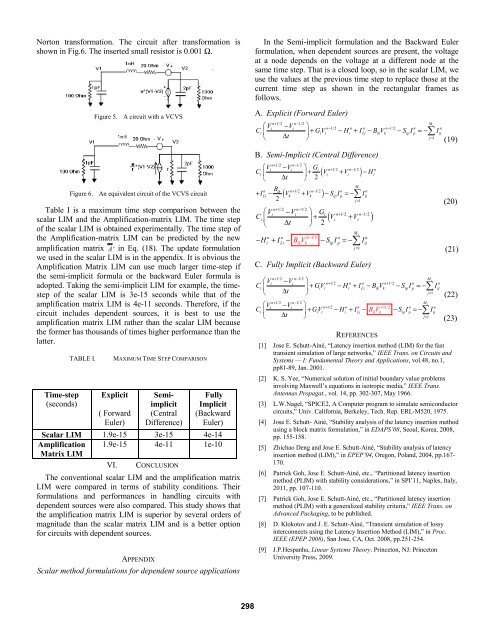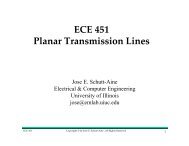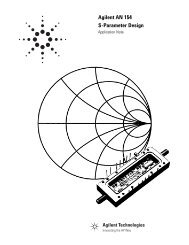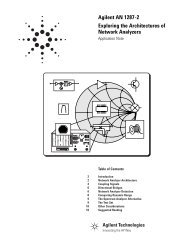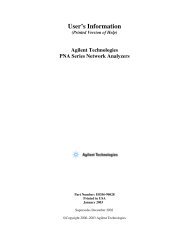A Comparison of Two Latency Insertion Methods in ... - IEEE Xplore
A Comparison of Two Latency Insertion Methods in ... - IEEE Xplore
A Comparison of Two Latency Insertion Methods in ... - IEEE Xplore
Create successful ePaper yourself
Turn your PDF publications into a flip-book with our unique Google optimized e-Paper software.
Norton transformation. The circuit after transformation isshown <strong>in</strong> Fig.6. The <strong>in</strong>serted small resistor is 0.001 Ω.Figure 5. A circuit with a VCVSFigure 6. An equivalent circuit <strong>of</strong> the VCVS circuitTable I is a maximum time step comparison between thescalar LIM and the Amplification-matrix LIM. The time step<strong>of</strong> the scalar LIM is obta<strong>in</strong>ed experimentally. The time step <strong>of</strong>the Amplification-matrix LIM can be predicted by the newamplification matrix A ' <strong>in</strong> Eq. (18). The update formulationwe used <strong>in</strong> the scalar LIM is <strong>in</strong> the appendix. It is obvious theAmplification Matrix LIM can use much larger time-step ifthe semi-implicit formula or the backward Euler formula isadopted. Tak<strong>in</strong>g the semi-implicit LIM for example, the timestep<strong>of</strong> the scalar LIM is 3e-15 seconds while that <strong>of</strong> theamplification matrix LIM is 4e-11 seconds. Therefore, if thecircuit <strong>in</strong>cludes dependent sources, it is best to use theamplification matrix LIM rather than the scalar LIM becausethe former has thousands <strong>of</strong> times higher performance than thelatter.Time-step(seconds)TABLE I.MAXIMUM TIME STEP COMPARISONExplicit( ForwardEuler)Semiimplicit(CentralDifference)FullyImplicit(BackwardEuler)Scalar LIM 1.9e-15 3e-15 4e-14Amplification 1.9e-15 4e-11 1e-10Matrix LIMVI. CONCLUSIONThe conventional scalar LIM and the amplification matrixLIM were compared <strong>in</strong> terms <strong>of</strong> stability conditions. Theirformulations and performances <strong>in</strong> handl<strong>in</strong>g circuits withdependent sources were also compared. This study shows thatthe amplification matrix LIM is superior by several orders <strong>of</strong>magnitude than the scalar matrix LIM and is a better optionfor circuits with dependent sources.APPENDIXScalar method formulations for dependent source applicationsIn the Semi-implicit formulation and the Backward Eulerformulation, when dependent sources are present, the voltageat a node depends on the voltage at a different node at thesame time step. That is a closed loop, so <strong>in</strong> the scalar LIM, weuse the values at the previous time step to replace those at thecurrent time step as shown <strong>in</strong> the rectangular frames asfollows.A. Explicit (Forward Euler)n+ 1/2 n−1/2M⎛Vii−V⎞<strong>in</strong>−1/2 n n n−1/2n nCi⎜ ⎟+ GVi i− Hi + ILi −BikVk − SipIp = −∑ Iij⎝ Δt⎠j=1 (19)B. Semi-Implicit (Central Difference)n+ 1/2 n−1/2⎛Vi −V ⎞iG<strong>in</strong>+ 1/ 2 n−1/2nCi⎜ ⎟+ ( Vi + Vi ) −Hi⎝ Δt⎠ 2M<strong>in</strong> Bikn+ 1/2 n−1/2n n+ ILi − ( Vk + Vk ) − SipIp =−∑ Iij2j=1n+ 1/2 n−1/2⎛Vi −V ⎞iG<strong>in</strong>+ 1/2 n−1/2Ci⎜ ⎟+ ( Vi + Vi)⎝ Δt⎠ 2M<strong>in</strong> n n−1/2n n− Hi+ ILi − BikVk− SipIp=−∑ Iijj=1C. Fully Implicit (Backward Euler)(20)(21)n+ 1/2 n−1/2M⎛Vii−V⎞<strong>in</strong>+ 1/2 n n n+1/2 n nCi ⎜ ⎟+ GVi i− Hi + ILi −BikVk − SipIp =−∑ Iij⎝ Δt⎠j=1 (22)n+ 1/2 n−1/2M⎛Vii−V⎞<strong>in</strong>+1/ 2 n n n−1/2 n nCi⎜ ⎟+ GVi i− Hi + ILi − BVik k− SipIp =−∑ Iij⎝ Δt⎠j=1 (23)REFERENCES[1] Jose E. Schutt-A<strong>in</strong>é, “<strong>Latency</strong> <strong>in</strong>sertion method (LIM) for the fasttransient simulation <strong>of</strong> large networks,” <strong>IEEE</strong> Trans. on Circuits andSystems — I: Fundamental Theory and Applications, vol.48, no.1,pp81-89, Jan. 2001.[2] K. S. Yee, “Numerical solution <strong>of</strong> <strong>in</strong>itial boundary value problems<strong>in</strong>volv<strong>in</strong>g Maxwell’s equations <strong>in</strong> isotropic media,” <strong>IEEE</strong> Trans.Antennas Propagat., vol. 14, pp. 302-307, May 1966.[3] L.W.Nagel, “SPICE2, A Computer program to simulate semiconductorcircuits,” Univ. California, Berkeley, Tech. Rep. ERL-M520, 1975.[4] Jose E. Schutt- A<strong>in</strong>é, “Stability analysis <strong>of</strong> the latency <strong>in</strong>sertion methodus<strong>in</strong>g a block matrix formulation,” <strong>in</strong> EDAPS’08, Seoul, Korea, 2008,pp. 155-158.[5] Zhichao Deng and Jose E. Schutt-A<strong>in</strong>é, “Stability analysis <strong>of</strong> latency<strong>in</strong>sertion method (LIM),” <strong>in</strong> EPEP’04, Oregon, Poland, 2004, pp.167-170.[6] Patrick Goh, Jose E. Schutt-A<strong>in</strong>é, etc., “Partitioned latency <strong>in</strong>sertionmethod (PLIM) with stability considerations,” <strong>in</strong> SPI’11, Naples, Italy,2011, pp. 107-110.[7] Patrick Goh, Jose E. Schutt-A<strong>in</strong>é, etc., “Partitioned latency <strong>in</strong>sertionmethod (PLIM) with a generalized stability criteria,” <strong>IEEE</strong> Trans. onAdvanced Packag<strong>in</strong>g, to be published.[8] D. Klokotov and J. E. Schutt-A<strong>in</strong>é, “Transient simulation <strong>of</strong> lossy<strong>in</strong>terconnects us<strong>in</strong>g the <strong>Latency</strong> <strong>Insertion</strong> Method (LIM),” <strong>in</strong> Proc.<strong>IEEE</strong> (EPEP 2008), San Jose, CA, Oct. 2008, pp.251-254.[9] J.P.Hespanha, L<strong>in</strong>ear Systems Theory. Pr<strong>in</strong>ceton, NJ: Pr<strong>in</strong>cetonUniversity Press, 2009.298


